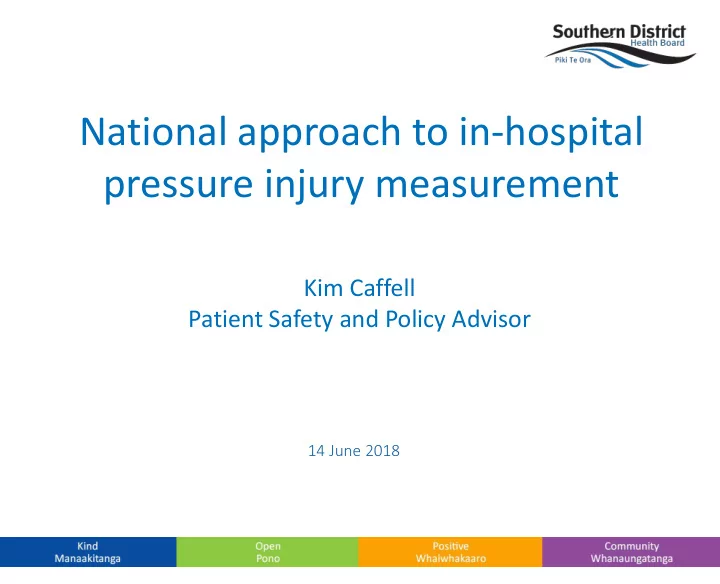

National approach to in-hospital pressure injury measurement Kim Caffell Patient Safety and Policy Advisor 14 June 2018
Past measurement approaches • No P&I audits since 2013 • Data from HRT 2016 showed increase in Stage 3 and 4 in SDHB • Review of recorded PI on Safety1st (incident management system) and in coding showed significant difference between reported pressure injuries of all stages.
Current measurement approach • A3 quality improvement methodology • Audit tool • Audit process
Version:27 Date: 16 May 2018 Title: Reducing pat ient harm from pressure inj uries Author: Sharron Feist, Alan Jones, Emil Schmidt, Mandy Pagan, Kirk Davidson, Andrea Dorne, Kim Caffell, Luciana What is the Problem? Blaga Problem Statement: We do not know how much harm is caused t o Target Condition: A system is in place to reliably gather data on pressure inj ury prevalence on admission, and identify how many our pat ient s wit h pressure inj uries in t he S out hern DHB PI occur in hospital (incidence). Background : A report from t he Healt h Round Table 2016 indicat ed t hat t he DHB had an increase in t he number of grade Proposed Solutions: Monthly auditing or randomised patients within 3 and 4 pressure inj uries across t he DHB. selected areas to more clearly identify the problem, and allow us to identify potential solutions to improve patient safety Evidence Proving the Problem: A review of recorded pressure inj uries was undertaken via safety 1 st and clinical coding. This highlighted a significant difference Implementation Plan: A staged roll out is now underway across district. between the reported number of pressure inj uries of all grades via both systems. It was • Ongoing also noted that both Invercargill and Dunedin hospital sites had not undertaken a hospital wide audit on pressure inj uries since 2013. There would appear to be significant • HQSC Quality markers are to be assessment and planning Ongoing as part of underreporting via the safety 1 st clinical incidents system: national work • Developing a list of ongoing activities that would feed into an ongoing programme around PI Audit day will be 2 nd Tues each month . Use Stop PI day each year as being a key • date to provide feedback to clinical areas (3 rd Thurs in Nov each year) Data from 2015-2016 Results: Summary of information from review of clinical records (NHIs generated from HRT report) Current Activity/ Finalising A3: • ACC funded PI position – work ongoing in recruitment. Looking at split FTE- 0.4 O& S , then 0.2 support/ proj ect • Improved return rates for May audit- ongoing processes to support implementation under Patient S afety currently. • Maternity (district), paeds/ NICU (Otago) and Mental Health (district)- not participating. Focus currently is on the areas where harm occurs –medical/ surgical and ATR. • Audit form and flow chart to be put on MIDAS (Kim) • Ongoing review of policies (CNS s) • Proj ect completed: - Communications (Kim/ S haron) - A3 sign off at Patient S afety meeting (S harron/ Kim)- 18 June Sign off: A3 Complete • Dist rict assessment form- consider as part of essent ials of care work (DoNs) (? Including educat ion) • Ongoing collect ion of dat a for Pat ient S afet y Markers ready for HQS C t imeframe (1 July 18) (Kim) Date: • Proj ect group may t ransit ion int o governance group for implement at ion of Guiding principles once posit ion appoint ed
Audit tool
Audit process
Key lessons learned • Keep the audit process as simple as possible • Don’t underestimate the support required to establish the audit process • Needs some form of centralized coordination • How your data will be collected/ collated important part of the project (keep the focus on HQSC markers- don’t make it too complex)
Results • Still early days • Still lots to do around PI- it can become overwhelming. Establish your audit processes first- other things will follow • Not all areas participating- MH, paeds & NICU (Otago), maternity • Not at the stage where we have enough data to share back with areas – key focus has been getting a regular sustainable process in place for auditing
Reporting
Actions • Essentials of care • Documentation • Education • Patient Safety Group • Opportunities- broader project to implement Guiding Principles for PI Prevention and Management in New Zealand (May17)
kim.Caffell@southerndhb.govt.nz sharron.feist@southerndhb.govt.nz
Recommend
More recommend